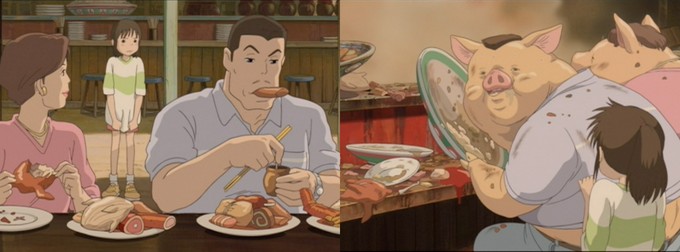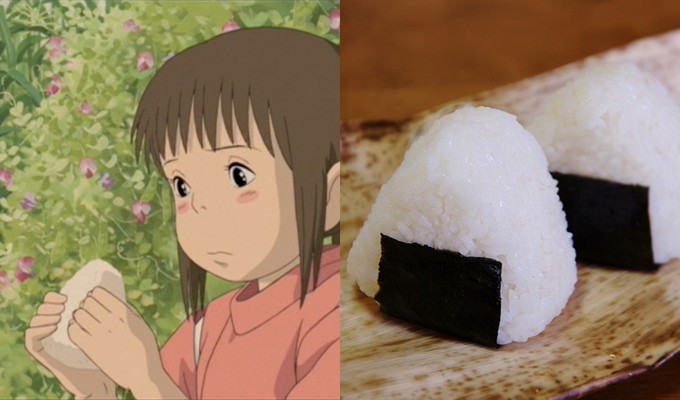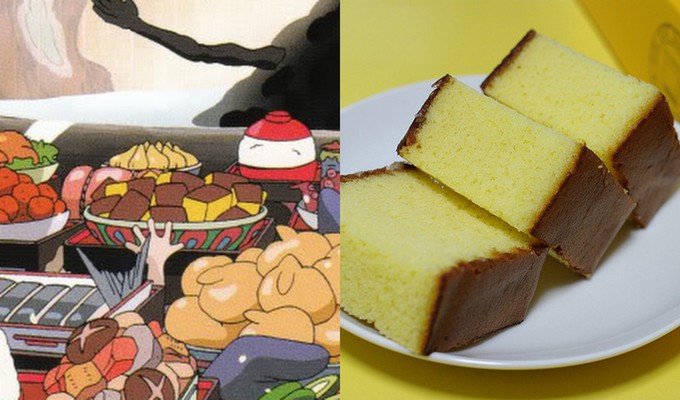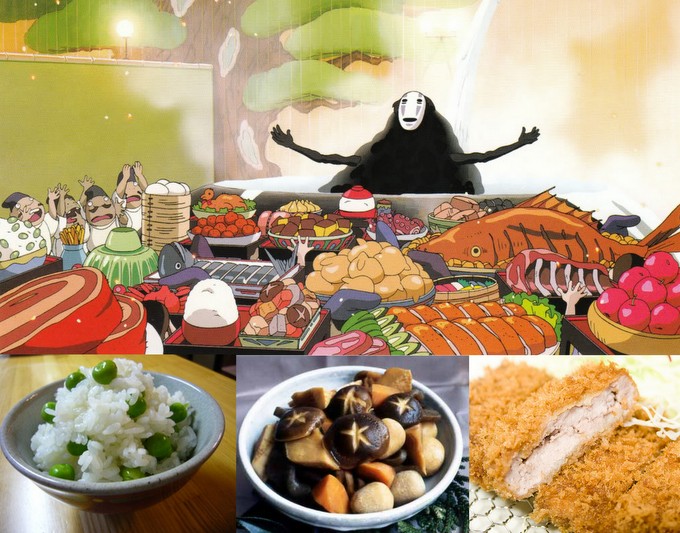This is a post about food, glorious food.
To be more precise, this is a post about the food depicted in Studio Ghibli films – always mouthwateringly detailed and remarkably true to life. Grave of the Fireflies, for example, featured candies in a rectangular can: they’re Sakuma Drops, still manufactured to this day. Then there was all the fuss about eating a pineapple in Only Yesterday – because at the time, imported fruit was rare and expensive.

Although food is certainly a scene-stealer in so many Studio Ghibli films, in no other film does it play a more important role than in Spirited Away. Think about it: if Chihiro’s parents weren’t such gluttons, they wouldn’t have become pigs and there would have been no story.

The neat thing about Spirited Away is that much of the food shown is typical Japanese fare – and boy, is there a lot of it. This movie makes for perfect Introduction to Japanese Cuisine 101 stuff. So why not?
First the Savories…
Onigiri おにぎり are rice balls. They’ve been around since at least the Heian period, and nowadays are easily available from any convenience store. They’re often triangular with a filling of some kind and wrapped in nori seaweed, although there really aren’t any hard and fast rules when it comes to onigiri. They’re also considered comfort food, so it’s no surprise that Haku consoles Chihiro with them after she finds out her parents really were turned into pigs.

Of course, the most food-centric event in Spirited Away must be when the bathhouse workers are falling over themselves to serve No-Face. Check out the following scene:

Can you spot the sushi platter? Sushi 寿司 is another classic Japanese dish, made of vinegared rice and some sort of topping or filling. There are loads of different types of sushi, but the ones shown in the screencap are: nigirizushi, rice topped with prawn or tuna or something; and makizushi, a roll of rice wrapped around whatever fillings you fancy and then sliced to serve.
Next to the sushi platter we have ishi yaki-imo 石焼き芋, or sweet potato slow-roasted on hot stones. This is a typical autumn snack in Japan, sold by peddlers from food carts or small trucks. Apparently you can hear the peddlers coming from miles away thanks to the peculiar singsong announcements they make.
Ikameshi イカ飯 also turns up in this scene. This is a Hokkaido dish of rice-stuffed squid simmered in soy sauce. Ikameshi was born out of necessity: during WWII squid was plentiful but rice was not, so ikameshi was the ideal way to compensate.
… Then the Sweets
Chihiro’s first encounter with Lin, her soon-to-be ally, was when the latter was feeding the soot sprites konpeito コンペイトー. These knobbly candies are basically just sugar and coloring, and easily available nowadays. Back when they were first introduced by the Portuguese, though, they were considered really posh. In fact, a Portuguese missionary allegedly bribed Oda Nobunaga for permission to preach Christianity in Japan with a bottle of konpeito.

As a human, Chihiro wasn’t exactly welcomed with open arms by the other bathhouse workers – that is, until she proved herself by successfully bathing the Stink God (who turned out to be the God of Rivers). As a “Hey, you’re all right,” gesture, Lin gives her an anman あんまん later that night. This is a steamed bun with a red bean paste filling, originally from China.

The sponge cake, castella カステラ, also makes an appearance. Once again, this is a foreign dish that the Japanese have adopted and made into their own: like konpeito, castella is also Portuguese in origin. There are lots of variations on it now, like green tea castella and chocolate castella, but the textbook example is still the plain, bright yellow castella with brown edges.

Honorable Mentions
The foods I’ve mentioned so far are just the tip of the iceberg, really. There are many more dishes in Spirited Away that I don’t know (or don’t consider typically Japanese). So I won’t try to describe them all, but here are a few more that I recognize:

At the far left you can just make out green peas rice. This is a type of maze 混ぜ gohan ご飯, basically just rice mixed with some other ingredient. Another variant is matsutake rice – matsutake mushrooms are damned expensive so mixing it up with rice is one way to make the meal go further.
At the bottom middle there is nishime 煮しめ, a typical New Year’s vegetable stew with carrots, mushrooms and konnyaku, a grey, jelly-type thing with practically no calories and full of fiber. Last but not least, right next to the nishime there is some form of katsu カツ: a chicken or pork cutlet, breaded and then deep-fried.
And there you have it! A whirlwind introduction to various Japanese foods, modern and traditional, sweet and savory, of foreign origin or a Japanese original.
